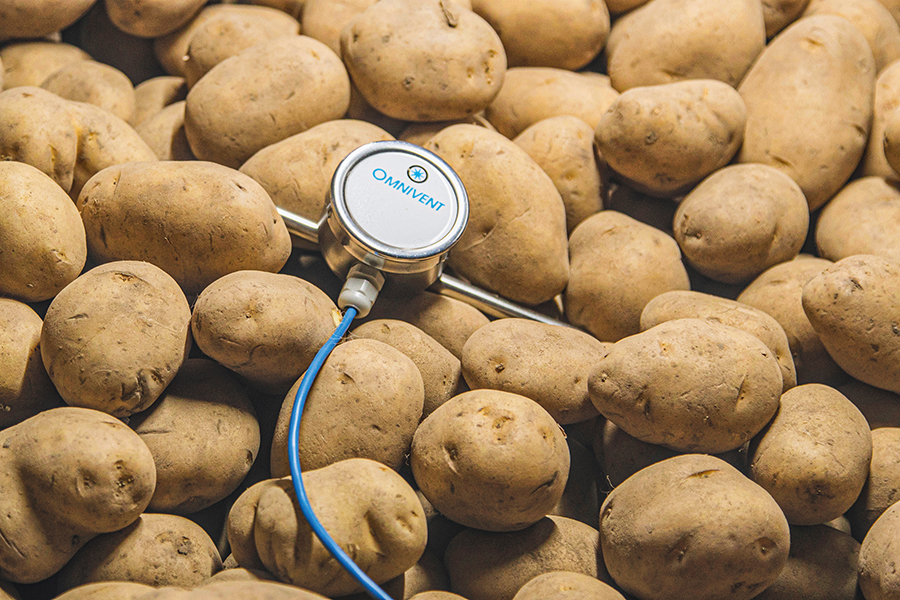Improving your bottom line with optimal potato storage
28th October 2024
Omnivent offers advice around what the ideal potato storage process should look like.

If storage conditions are poor, you may face losses due to rot, sprouting or dehydration. The quality of your potatoes can also deteriorate as sugar content increases. Therefore, it’s important to make sure you have the right knowledge and control over conditions in your store.
Roughly speaking, five stages can be distinguished when storing potatoes. These specific conditions may vary depending on the potato variety and harvesting conditions.
1. Loading & equalising
During storing, it is important to fill the shed as quickly as possible and to get an even temperature. If it takes more than a week between storing the first and the last batch, there will be big differences in the conditions of the potatoes in storage.
2. Drying & healing
Once all the potatoes have been stored in, drying and healing (subrization) can begin. Healing requires a temperature of at least 12ºC. There is a high risk of rot spread, when the temperature rises above 18ºC. Also, make sure to create a high relative humidity of at least 90%.
When drying the potatoes, the relative humidity goes down. Because of the difference in relative humidity, wound healing and drying cannot take place optimally at the same time. Therefore, the biggest weight losses often occur in this phase. It’s important to find the right balance between drying and wound healing.
3. Cooling down
You can start cooling when the potatoes are almost dry. If you’re only able to cool with outside air, make sure the final temperature is not reached until early December. This prevents disruption of the potatoes when the outside air is too warm. You can cool down faster with mechanical cooling, at a maximum of 0.3ºC per day for seed potatoes or a maximum of 0.5ºC per day for other potatoes.
While doing so, keep the CO2 concentration below 2,500ppm, depending on the variety. Having the right levels of CO2 will avoid suffocation of your potatoes and also optimise the colour of potatoes that are destined for frying.
4. Storage
Depending on the length of storage and the dormancy period, sprout inhibitors will have to be applied at some point. A batch of potatoes often needs to be treated several times.
5. Warming up
Just before unloading, we recommend slightly warming up your potatoes, to a temperature of 12–15ºC. This prevents subcutaneous tissue discolouration.
Avoid these common mistakes
Annually, our storage specialists visit hundreds of stores across Northern Europe, including the UK. It’s not uncommon for us to meet store owners who make some basic mistakes in their storage that can be prevented.
Not having enough ventilation capacity
To avoid the spread of rot when storing, make sure you have enough ventilation capacity. We recommend at least 100 cubic meter air per cubic meter potatoes per hour. When the quality of inbound potatoes is bad, you’ll need forced ventilation (instead of room ventilation) for proper drying performance. This requires a higher investment, but it will pay off in the bad years.
Lacking control over humidity
Potatoes require at least 95% relative humidity when storing. Mechanical cooling lowers the relative humidity and can cause serious dehydration. Having a humidification system helps you control the humidity in your store. It also means you’ll need less energy for cooling, because humidification has a cooling effect.
Running fans for too long
Every hour of ventilation causes dehydration, which means more weight loss and pressure bruises. An automated storage program that monitors and controls your fans helps to minimise running hours, and your energy bills.
Using too much energy when refreshing CO2
Conventionally, refreshing CO2 is done by opening hatches and running the big system fans. This method costs a lot of energy. CO2 is heavier than air, which means you can use a CO2 extraction system.
These systems only contain a piping system with a small efficient fan. This extracts air with a high CO2 concentration from the bottom of the store. Only small amounts of outside air are needed to replace the extracted air. This method is more energy efficient and barely affects the temperature and humidity in your store.
Optimising your storage will reduce losses while keeping your potatoes in the best possible shape. It will also help you get the best price for your potatoes or have as many potatoes as possible available for processing.
Omnivent says it makes it easy to store your crops in perfect conditions, by providing the best expertise and techniques, so you can concentrate on the job in the field. Head to the Omnivent website for more information.
Read more arable news

